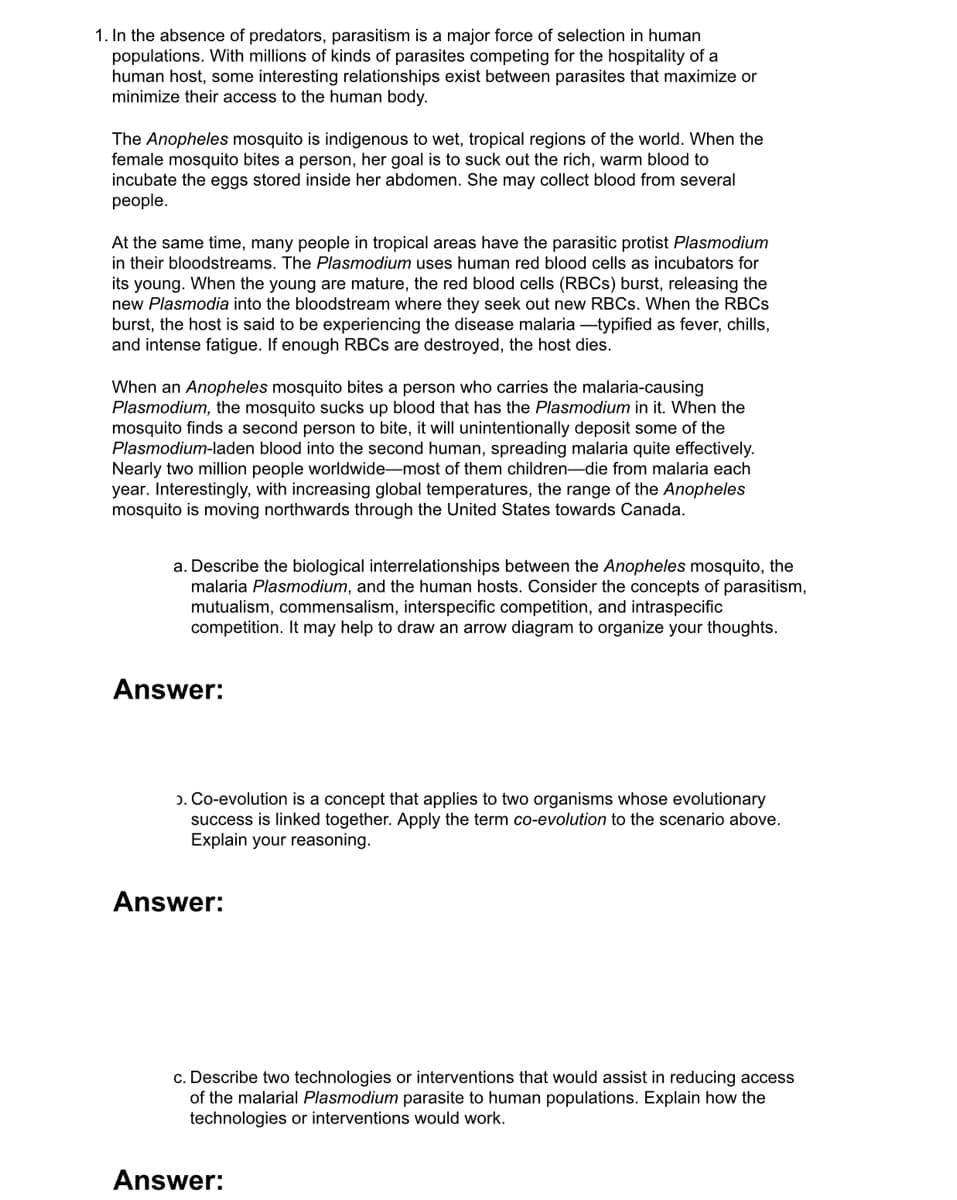mosquito is moving northwards through the United States towards Canada. a. Describe the biological interrelationships between the Anopheles mosquito, the malaria Plasmodium, and the human hosts. Consider the concepts of parasitism, mutualism, commensalism, interspecific competition, and intraspecific competition. It may help to draw an arrow diagram to organize your thoughts.
mosquito is moving northwards through the United States towards Canada. a. Describe the biological interrelationships between the Anopheles mosquito, the malaria Plasmodium, and the human hosts. Consider the concepts of parasitism, mutualism, commensalism, interspecific competition, and intraspecific competition. It may help to draw an arrow diagram to organize your thoughts.
Biology: The Unity and Diversity of Life (MindTap Course List)
15th Edition
ISBN:9781337408332
Author:Cecie Starr, Ralph Taggart, Christine Evers, Lisa Starr
Publisher:Cecie Starr, Ralph Taggart, Christine Evers, Lisa Starr
Chapter29: Life Cycles Of Flowering Plants
Section: Chapter Questions
Problem 2CT: All but one species of large birds native to New Zealands tropical forests are now extinct. Numbers...
Related questions
Question

Transcribed Image Text:1. In the absence of predators, parasitism is a major force of selection in human
populations. With millions of kinds of parasites competing for the hospitality of a
human host, some interesting relationships exist between parasites that maximize or
minimize their access to the human body.
The Anopheles mosquito is indigenous to wet, tropical regions of the world. When the
female mosquito bites a person, her goal is to suck out the rich, warm blood to
incubate the eggs stored inside her abdomen. She may collect blood from several
реople.
At the same time, many people in tropical areas have the parasitic protist Plasmodium
in their bloodstreams. The Plasmodium uses human red blood cells as incubators for
its young. When the young are mature, the red blood cells (RBCS) burst, releasing the
new Plasmodia into the bloodstream where they seek out new RBCS. When the RBCS
burst, the host is said to be experiencing the disease malaria –typified as fever, chills,
and intense fatigue. If enough RBCS are destroyed, the host dies.
When an Anopheles mosquito bites a person who carries the malaria-causing
Plasmodium, the mosquito sucks up blood that has the Plasmodium in it. When the
mosquito finds a second person to bite, it will unintentionally deposit some of the
Plasmodium-laden blood into the second human, spreading malaria quite effectively.
Nearly two million people worldwide-most of them children-die from malaria each
year. Interestingly, with increasing global temperatures, the range of the Anopheles
mosquito is moving northwards through the United States towards Canada.
a. Describe the biological interrelationships between the Anopheles mosquito, the
malaria Plasmodium, and the human hosts. Consider the concepts of parasitism,
mutualism, commensalism, interspecific competition, and intraspecific
competition. It may help to draw an arrow diagram to organize your thoughts.
Answer:
ɔ. Co-evolution is a concept that applies to two organisms whose evolutionary
success is linked together. Apply the term co-evolution to the scenario above.
Explain your reasoning.
Answer:
c. Describe two technologies or interventions that would assist in reducing access
of the malarial Plasmodium parasite to human populations. Explain how the
technologies or interventions would work.
Answer:
Expert Solution
This question has been solved!
Explore an expertly crafted, step-by-step solution for a thorough understanding of key concepts.
Step by step
Solved in 2 steps

Knowledge Booster
Learn more about
Need a deep-dive on the concept behind this application? Look no further. Learn more about this topic, biology and related others by exploring similar questions and additional content below.Recommended textbooks for you

Biology: The Unity and Diversity of Life (MindTap…
Biology
ISBN:
9781337408332
Author:
Cecie Starr, Ralph Taggart, Christine Evers, Lisa Starr
Publisher:
Cengage Learning

Biology Today and Tomorrow without Physiology (Mi…
Biology
ISBN:
9781305117396
Author:
Cecie Starr, Christine Evers, Lisa Starr
Publisher:
Cengage Learning

Biology: The Unity and Diversity of Life (MindTap…
Biology
ISBN:
9781305073951
Author:
Cecie Starr, Ralph Taggart, Christine Evers, Lisa Starr
Publisher:
Cengage Learning

Biology: The Unity and Diversity of Life (MindTap…
Biology
ISBN:
9781337408332
Author:
Cecie Starr, Ralph Taggart, Christine Evers, Lisa Starr
Publisher:
Cengage Learning

Biology Today and Tomorrow without Physiology (Mi…
Biology
ISBN:
9781305117396
Author:
Cecie Starr, Christine Evers, Lisa Starr
Publisher:
Cengage Learning

Biology: The Unity and Diversity of Life (MindTap…
Biology
ISBN:
9781305073951
Author:
Cecie Starr, Ralph Taggart, Christine Evers, Lisa Starr
Publisher:
Cengage Learning

Biology: The Dynamic Science (MindTap Course List)
Biology
ISBN:
9781305389892
Author:
Peter J. Russell, Paul E. Hertz, Beverly McMillan
Publisher:
Cengage Learning